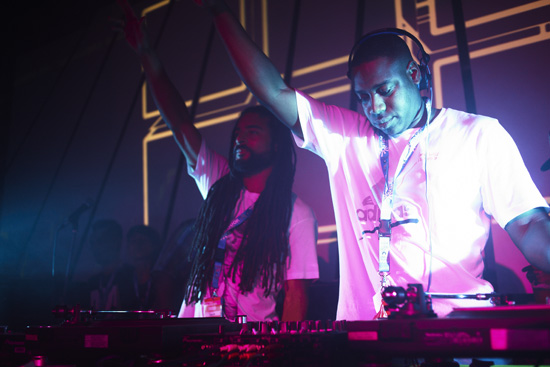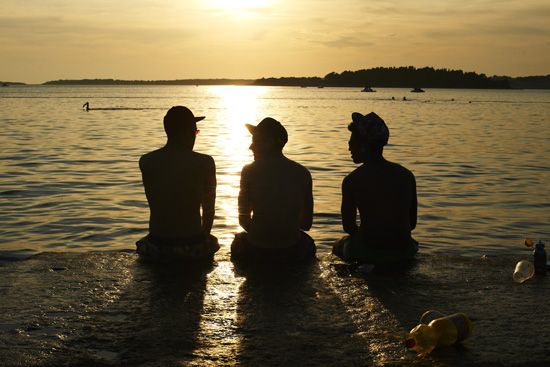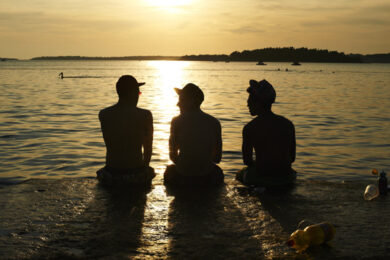How, I asked an Outlook veteran, would I know where to go for my connection at Venice airport? Easy, they replied – look for loads of rich kids talking in slang. And, sure as eggs is eggs, within 30 seconds of emerging from the arrivals gate I heard, loud and clear, “OH MY GOD, THIS IS GOING TO BE, LIKE, TOTALLY JOKES YEAH?” and saw a large cluster of boys and girls with the sort of immaculately-tousled hair that only the output of Britain’s most expensive schools seem able to cultivate.
Yes, it was impossible to ignore: there were an awful lot of tanned and healthy upper middle class youth on their way to the festival of ‘bass music and soundsystem culture’ on the beautiful Adriatic coast of Croatia. Many were even ‘doing the circuit,’ spending a whole summer taking in the many boutique festivals that have sprung up in ex-Eastern Bloc countries over the past few years. It was all an absolute gift to the kind of sour-faced purists who have long been keen to write off dubstep and all that has sprung from it as somehow gentrified and lacking in authenticity as compared to grime, road rap or whatever other signifier of nitty-gritty realness is de rigeur at the time.
With each step closer to Outlook, though, it became clear that my contact’s characterisation of the festival – while amusingly well observed – was only a small part of the story. Milling about waiting for the four hour (and, oh fuck, non air conditioned in 30-degree-plus heat) coach ride into Croatia were grime crews, lairy ravers and general spotty herberts from all over Britain, including what appeared to be half the population of Leeds.
The latter are very siginificant. Outlook, though now grown into a fully-fledged festival, began four years back as a jolly – essentially a club night in the sun – for a circle of friends who ran clubs up north, particularly in Leeds, and a few hundred regulars. And there seems to remain a distinctly northern no-nonsense attitude to genre and scene to the way the festival is programmed. Rather than worry about micro-delineation and definition of 21st century sounds, these sounds are simply treated as continuations and extensions of the long-running British love for and assimilation of black music. Grime and funky are easily fitted in alongside reggae, soul, hip-hop, jungle, techno – and lots and lots of dubstep. It remains 85-90% British at a rough guess, but it looks to be becoming more cosmopolitan by the year, with a healthy number of Croats in attendance in particular.

It all looked a bit wobbly on arrival, though. The horns we heard sounding as we approached the festival site were sadly not those of junglist ravers, but of coaches and cars trapped in absolute gridlock trying to get in and out of the carpark. On eventually reaching the site entrance, things didn’t seem much better with gigantic queues for wristbands and accommodation passes, and one Croatian steward muttering to me that the weekend would be “chaos,” then repeating, in a near-bellow, “CHAOS!” Given the exponential increase in demand, the Outlook organisers have almost quadrupled the festival’s capacity from 4,000 in 2010 to 15,000 – with stages along the beach as well as in the 19th century fort above it which held the festival last year – and it looked a lot like their infrastructure was creaking under the weight of this unprecedented expansion.
Amazingly, the crew were clearly learning on the job and learning fast – this visible disorganisation lasted only up to the beginning of the festival proper the following day, and from there on in it was as slick as any festival I’ve been to. The nine main stages and untold beach and boat parties all had 100% on point soundsystems, acts appeared pretty much on time (astoundingly in some cases given the state of some of dubstep’s finest after three or four days), there were few bottlenecks getting in and out of arenas and queuing for food and drink was minimal. Queues for nitrous were another matter, perhaps aggravated by the general lack of illegal drugs, but if having to stand around a bit to get a balloon is the worst complaint you’ve got about a festival then you’re not doing too badly.
And the music on those soundystems? Well the short answer is that it was all good. Really. There was no filler, nothing booked because it was hip or of the moment – every stage was put together by aficionados for aficionados, by party people for party people. I might not have much time for the repetitions of liquid drum’n’bass, say, but venturing into areas where it was playing it was clear that the absolute cream of the style were DJing and the atmosphere was as live as everywhere else. The long answer is too long to give here: the festival genuinely was a four-day rave (longer for many people) and to try and give a narrative of the whole thing, complete with every musical highpoint, would take more time than you or I have to spare. Let’s look at some key moments, though…
Reggae and dancehall were everywhere. Horace Andy and Janet Kay shone on the main stage, both surely nearing retirement age, but both still with vocals capable of taking your breath away from half a mile away. Rob Smith – aka RSD, More Rockers and the Smith of Smith & Mighty – drew together three decades of Bristolian sound from the Dugout to Dubloaded in his rolling breaks and that amazing hollow bass sound that only he seems able to make. Congo Natty shifted back and forth between Jamaican classics and junglist remakes, a simple formula but a devastating one. Kevin Martin as The Bug played a straight-up dancehall instrumental set with very few of the noise excursions you might expect from him, instead making loads of space for Daddy Freddy’s wild vocals. Again getting on in years, D.F. didn’t stop whipping the crowd’s enthusiasm up the whole set long, one foot up on the monitors and his pinpoint-accurate hyperspeed ragga chat still full of raw power, showing exactly how much jungle (and thus grime) MCs owe to him personally.
Heatwave too built up dangerous energy levels with mid-afternoon campsite parties; I don’t know if it’s being part of the YouTube generation, but half the crowd under the age of 25 – including the posh kids – seemed to know the lyrics to every dancehall record ever made. The varied, but predominantly Caucasian, crowd getting a full-tilt bashment groove on made a fascinating sight, a million miles away from the kind of awful clip-on-dreadlock gap year worthies skanking awkwardly to “roots ‘n’ culture, yah” that I remember from my 20s a decade ago. Pretty joyful really. But not as joyful as David Rodigan on the opening night, doing what David Rodigan does. If you’ve seen it you know, if you haven’t you must. But in front of thousands of people completely versed in the music he plays, his perpetual enthusiasm was amplified tenfold – truly Outlook’s spiritual father.

There were genre-agnostic acts too. I came off the Urban Nerds boat party – which had seen original UK garage dons El-B and Zed Bias play one of the best party sets I have seen in a very long time – just in time to run up to the main courtyard of the fort and see Rustie and Hudson Mohawke get very, very weird. Long ambient interludes, prog rock crescendos, happy hardcore rushes, beats that came in diagonally at the most unexpected moments – none of it should have worked as rave music, it should in theory have been awful IDM wank, but somehow their Glaswegian party instinct shone through and they kept their crowd wigging out, if in slightly bemused fashion.
At various other points Kidkanevil delivered deeply psychedelic digital hip hop, Kyle Hall and Floating Points reminded us exactly how versatile and vital real house music is in 2011, Instra:mental turned old-school b-boy electro into something monumental and brutal with 808 kickdrums the size of Bosnia, Ikonika somehow blended techno so relentlessly pounding as to be bordering on Goa trance with her more recognisable video-game-R&B-step, and Pangaea built steadily from a stately near-ambient beginning through all kinds of twists and turns ’til he reached classic early 90s rave (“cut the midrange, drop the bass”) while still sounding completely of the now. I could go on – the point is, standing under the stars or in the dungeon of the fort, with those huge rigs in full effect, there is no ‘post’ this, ‘future’ that or ‘hybrid’ the other, just a spectrum of sounds that is constantly being refined, renewed and added to in the social laboratory that is the rave.
And then there was the dubstep. I did hear a couple of people complain there was too much – which frankly is like whingeing about too many guitars at Download. There was plenty of dubstep to go round and then some, that’s for sure, but it showed how broad a church the scene is now. Of course, there was plenty of noisy stuff. My old ears couldn’t handle the entire sets by Stenchman and Dr P that I saw, but on the Fort soundsystem, it was a truly mind-melting barrage of sound, far more varied and full of funk than the ‘brostep’ naysayers would have you believe, with Stenchman’s set in particular drawing in rattling sped-up UK funky rhythms to brilliant effect. It’s worth noting how close Logan Sama’s full-scale grime set came to the fearsome tear-out dubstep style at various points, and how when MC P Money stayed onstage afterwards he insisted that Plastician began his set with Flux Pavilion’s ‘Bass Cannon’. It may be screechy and brutal, with core appeal to boys with their shirts off (I saw a couple of fights kick off in the moshpit to Dr P), but this sound is right at the core of British underground music right now.
Skream and Benga got pretty loony on that front too. Both are clearly bathing in their superstardom at the moment, and their main stage sets are full of the flashy big gestures they have honed while playing to crowds of tens of thousand Stateside. Benga’s solo set was full of insanely sugary trance rushes, each followed by a monstrous bassline drop bordering on the industrial – while his and Skream’s joint set was manic to the point of creating a new genre entirely: pushing 150bpm, it was glossy, sharp-edged hardcore music, strictly for a keyed up and manic crowd. If we thought at any point that the two were showboating, though, on Sunday night Skream went in hard with the rhythmic tracks for a late set on one of the smaller stages outside the fort, arms flashing across the decks as if determined to prove that he can still mix like a demon. That he was still upright at this point was something of a miracle, but to pull a killer set out of the bag was superhuman.
At the other end of the spectrum, Pinch, Loefah and Scuba all played sets that strayed well into deep techno territory but retained the particular immersiveness and soundsystem power that could only come from deep roots in dubstep. Shackleton, as ever, created whole worlds of his own from that techno / sub-bass starting point. But for my money some of the best moments of the weekend came from heartland dubstep, from those still confident to let a halfstep rhythm and monumental bass do the work without recourse to either noise or nudging into other genres. Cotti warmed up the Fort stage amazingly on Saturday, his churning scrambled-egg sounds and snappy drums providing a framework for three MCs standing on top of massive speaker towers, arms raised to welcome the thunderstorm.

Mala and Coki – Digital Mystikz – were wild, demonstrating why they are still leaders, managing to be both deep and rambunctious with a set that wove a vivid and ragged tapestry of underground sounds, with Coki constantly breaking a self-imposed ‘no rewinds’ rule as Sergeant Pokes on the mic hollered “GUILTY!” Quest and Silkie, also on the DMZ stage, proved their slick soulfulness crackles with raw energy in the live setting. And earlier still that evening, Distance and Tunnidge – in certain senses the purest of dubstep purists – provided one of the most mind-cleansing experiences of the whole festival, a completely absorbing hour of low frequencies expanding and contracting around us like a living sculpture.
I’m aware that all this could sound uncritical, and I’m laying myself open to charges of (oh no!) ‘boosterism’. But it would take a dedicated contrarian to stand in the midst of that atmosphere and claim – as some still do – that dubstep is over-serious, blokey, po-faced, or that it is somehow a spent creative force. It is dubstep that has drawn together all the threads of the UK underground, from Glaswegian experimentalists to old school junglists, meditative techno-heads to soulboys, b-boys to moshpit nutbars. And it’s Outlook that more than any event in the calendar represents that set of connections, and how they are still being solidified and expanded. Whether it can continue to expand and still retain the family feeling it has now – the sense that audience, organisers and acts are part of the same network – remains to be seen. But right now, it remains a beacon of the rude health of soundsystem culture and, more to the point, a ridiculous amount of fun.
I’ve remembered one downer though: the dust. On arriving at the festival itself on my second day, I scoffed at middle-class boys wearing gang style bandanas over their faces. ‘Pricks,’ I thought. Two days and a hacking cough later, I realised they were more sensible than I’d given them credit for. Maybe not as sensible was the Sloaney girl who was willing to jettison a £400 pair of trainers to get her hand baggage down to Ryanair’s required size on the way home (until my gallant travelling companion stepped in and stowed them in his satchel for her). That moment, like many over the preceding five days, was indeed, like, totally jokes, yeah?
Photos by Marc Sethi



